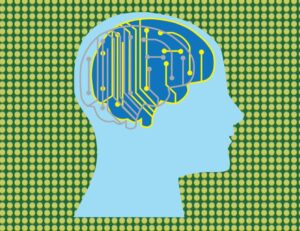
picture credits to owner
Fascinating coding, we have here
Predictive coding has become one of the most fascinating and influential theories in neuroscience today. At its core, predictive coding suggests that the brain is not a passive receiver of information but rather a constant predictor. When our brains compare these predictions to actual sensory input, the brain updates its beliefs and refines its view of the world. This ‘simple’ process might explain not only basic perception but also complex psychological phenomena – from mental health conditions to the effects of therapy and psychedelics.
Prediction to perception
At a basic level, predictive coding means that our brains are wired to expect certain patterns. De-wit and colleagues (2010) explain that predictive coding allows the brain to efficiently process information without having to redundantly store the same data at every stage of the neural hierarchy. Instead, only the differences (otherwise known as ‘prediction errors’) between what was expected and what actually happens are passed along for deeper processing.
This principle of efficient coding is not just to save our resources but also allows us to react quickly to changes in our environment, recognize familiar patterns almost instantly, and focus our attention where it is needed most.
Predictive coding across development and disorders
Researchers today are also exploring how predictive coding develops over a lifetime. Marais and Roche-Labarbe (2025) highlight that sensory prediction and attention are deeply interconnected from infancy. In typically developing children, the ability to predict sensory experiences co-evolves with the ability to selectively focus attention. This is critical for both learning and adaptive to new environments.
It is also interesting to note that predictive impairments may lie at the heart of neurodevelopmental disorders like autism spectrum disorder (ASD). Individuals with ASD might struggle with forming or updating predictions about their environment, which could partly explain sensory sensitivities and challenges in social interactions. Understanding predictive coding in early development may eventually lead to earlier detection of atypical neurodevelopment and more targeted interventions.
Going beyond sensation and into our emotions
Predictive coding does not just affect how we see or hear the world – it touches our deepest emotions and sense of self. Briggs (2018) points that when our brains encounter major mismatches between expectation and reality, it can create profound emotional responses. For instance, if you expect others to reject you but receive kindness instead, the resulting “prediction error” might cause strong feelings of surprise, confusion and sometimes, relief.
This theory opens up a whole world of possibilities in the realm of mental health. Psychedelics, for example, are thought to reduce rigid predictive habits linked to anxiety and depression. By loosening these fixed expectations, individuals may become more open to seeing themselves and their futures differently. This is a key mechanism thought to underlie the therapeutic potential of psychedelic-assisted therapy.
Responding to broken expectations
Neuroimaging research offers insights to what happens to the brain when predictions go south. It was found that two regions – the anterior insula and the inferior frontal gyrus – are especially sensitive to prediction violations (Ficco et al., 2021). These areas help track bodily sensations, emotional reactions and decision-making under uncertainty.
The anterior insula seems to be deeply involved in processing prediction errors related to an individual’s sense of self and bodily awareness. Whether it is the surprise of an unexpected touch or a shocking piece of news, both regions work together to detect and respond to mismatches between our expectations and reality. Their activity might also explain why some people find uncertainty particularly stressful or anxiety-inducing – a brain that is deeply attuned to prediction violations might constantly signal “something is going wrong” even when there is no imminent danger.
A new principle and predictive coding
Zooming out further, predictive coding fits into a broader theory known as the Free Energy Principle (FEP). The FEP proposes that all biological systems (inclusive of the human mind), work to minimize “free energy” (the difference between predicted and actual experiences). In other words, to survive and thrive, organisms must constantly reduce surprise and maintain a stable sense of the world (Holmes, 2022).
There is also an interesting connection between FEP and psychoanalytic ideas as well as psychotherapy. Therapy, from this perspective, can be seen as helping individuals deeply held (and sometimes maladaptive) predictions about themselves and others. In cases of profound mental distress (e.g., personality disorders), therapies grounded in predictive coding models such as mentalization-based therapy (MBT) are showing real promise.
Conclusion
Predictive coding is much more than a dry computational therapy – it is a powerful lens for understanding how we perceive, feel, grow, and sometimes heal. From the infant learning to make sense of a noisy world, to the adult grappling with anxiety, to the brain on psychedelics exploring new possibilities, predictive coding offers a unified framework for possibly explaining it all. As research continues to deepen, predictive coding is likely to play an even greater role in neuroscience, psychology, psychiatry and beyond. It reminds us that every moment, we are no longer merely reacting to the world around us – we are actively predictive, shaping it and sometimes reshaping ourselves.
Written By:
Cassandra Selvan
Singapore University of Social Sciences
References:
Briggs, S. (2018, December 29). How predictive coding is changing our understanding of the brain. Mind Foundation. https://www.mind-foundation.org/blog/predictive-coding
De-Wit, L., Machilsen, B. & Putzeys, T. (2010). Predictive coding and the neural response to predictable stimuli. Journal of Neuroscience, 30(26), 8702-8703. https://doi.org/10.1523/jneurosci.2248-10.2010
Ficco, L., Mancuso, L., Manuello, J., Teneggi, A., Liloia, D., Duca, S., Costa, T., Kovacs, G. Z. & Cauda, F. (2021). Disentangling predictive processing in the brain: A meta-analytic study in favor of a predictive network. Scientific Reports, 11(16258). https://doi.org/10.1038/s41598-021-95603-5
Holmes, J. (2022). Friston’s free energy principle: New life for psychoanalysis? BJPsych Bulletin, 46(3), 164-168. https://doi.org/10.1192/bjb.2021.6
Marais, A. L. & Roche-Labarbe, N. (2025). Predictive coding and attention in developmental cognitive neuroscience and perspectives for neurodevelopmental disorders. Developmental Cognitive Neuroscience, 72, 1-17. https://doi.org/10.1016/j.dcn.2025.101519

Leave A Comment